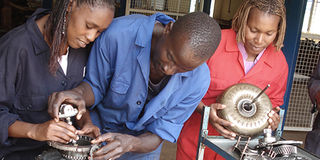Youth polys plunge to dismal depths

File | NATION
Student mechanics busy at work. Recent national examination results were anything but encouraging as more than 50 per cent of students in youth polytechnics failed carpentry, electrical and electronics courses.
What you need to know:
- Recent national examination results were anything but encouraging as more than 50 per cent failed carpentry, electrical and electronics courses
The next time you call a young man to fix your lights or repair the book case, remember to check his credentials first: results from national electrical and carpentry tests indicate that the majority of students enrolled in Kenya’s 63 youth polytechnics failed in these two subjects.
Quietly handed over to the Ministry of Youth Affairs without the usual pomp and glamour that goes with the release of national examinations, the National Vocational Certificate of Education and Training (NVCET) results came as the government finalises plans to inject Sh3 billion in the youth polytechnics.
They were anything but encouraging: 58 per cent of students who sat national carpentry tests in 2010 failed; six per cent were given referrals. In the electrical and electronics class, 56 per cent failed, while 12 per cent were given referrals.
Only four candidates passed in such courses as leatherwork technology. Overall, the performance dropped from 76 per cent pass rate in 2009 to 69 per cent in 2010,
The number of students who sat for NVCET also dropped by 20 per cent — from 1,040 in 2009 to 839 in 2010. This, according to government officials, is largely caused by a negative perception of youth polytechnics by thousands of Class Eight graduates who fail to secure secondary school places.
According education experts, many youngsters still regard youth polytechnics as institutions for failures, a trend that has resulted in many of them sinking into decay.
Director of Youth Training Dinah Mwinzi says negative comments from primary school heads do not help the situation.
“Many teachers tell their pupils that if they fail their exams they will end up at the local polytechnic,” she said.
Higher Education assistant minister Kilemi Mwiria concurs.
“There are still historical stereotypes surrounding youth polytechnics that we need to counter. For years, our people have been going to polytechnics and institutes of technology as a last option and we need to change our people’s mindset,” Dr Mwiria says.
One of the biggest flaws in Kenya’s education system, he says, has been the emphasis on degrees and diplomas at the expense of the more practical training in youth polytechnics.
“I dare say that for every one degree, we need eight technical guys. Maybe it is time to ask ourselves: Do we need all those degrees or guys who can fix things?” Dr Mwiria poses.
Teachers in youth polytechnics agree.
Years of negative perceptions have translated to decades of decay in the polytechnics.
“Youth polytechnics had declined and many have died out due to mismanagement. They also lack tools and equipment for training,” says Mr Leornard Ojwang, the manager of Kabula Youth Polytechnic.
He has been at the institution for 20 years as an instructor in agriculture and now as an administrator.
To counter the negative perception, the government is working on a new system to convince students in youth polytechnics that they can still work their way to universities like their colleagues in secondary schools.
A new curriculum gives poly trainees a chance to advance their education up to the highest level of education at university.
The new curriculum, introduced in the polytechnics two years ago, sought to revamp the youth institutions and make them viable options for those who were sifted out of mainstream education system by the Kenya Certificate of Primary Education (KCPE) national examination.
Under the curriculum, polys were to offer an alternative route of progression through various levels of technical training up to the award of a technical degree.
The move seeks to curb the annual wastage of an estimated 200,000 primary school leavers whose grades do not meet the secondary school cut-off mark by convincing them that high school is not the only route to university.
However, Ms Mwinzi says the trainees will have to wait a while longer before they can use youth polytechnics as a route to earn a technical degree at the university.
According to Ms Mwinzi, the delay is caused by a lack of science laboratories, which would facilitate rolling out of general education subjects like biology, physics, chemistry and Information Technology alongside technical subjects.
“We have not even piloted the academic option (option two), which is meant for those who want to pursue a technical degree after attending various levels of training starting at the youth polytechnic,” Ms Mwinzi says.
Assistant minister for Youth Affairs and Sports Wavinya Ndeti says Sh1.3 billion will be spent on rehabilitating infrastructure and buying equipment to improve the quality of training in the polytechnics.
“We will use these funds to build workshops, computer laboratories, hostels and greenhouses and also to recruit qualified instructors,” she said.
Sh890 million has been set aside to subsidise tuition to increase access for poor students.
But amidst the gloom cast by the poor performance in some of the subjects, some youth polytechnics still shone in various crafts.
In Rift Valley, three polytechnics — Mogotio, Kapenguria and Iten — shone in hairdressing and beauty therapy, motor vehicle technology and electrical technology.
Nyaga polytechnic in Central shone in Information Communications Technology while Sero in Nyanza excelled in building construction.
Mwanjila Youth Poly in Coast was outstanding in food processing technology while Kabula in Western shone in agri-business studies. Other outstanding youth polytechnics included Mitaboni in Eastern (electrical and electronics) and St Josephs, Isiolo (motor vehicle technology).




